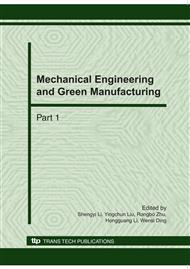[1]
Cho M. H., 2006, Numerical simulation of arc welding process and its application, PhD Thesis, Ohio state university, pp.129-137.
Google Scholar
[2]
Fabbro Remy, Chouf Karim. 2000, Keyhole description in deep penetration laser welding. Proceedings of SPIE, 3888, 104-112.
DOI: 10.1117/12.377087
Google Scholar
[3]
Fabbro R., Chouf K., 2001, Keyhole modeling during laser welding. Journal of Applied Physics. 87 (9), 4075-4083.
DOI: 10.1063/1.373033
Google Scholar
[4]
Farson D., 2006, Simulation-based and Experimental Development of Hybrid Laser Welding Processes. Proceedings of international symposium on computer-aided welding engineering, Jinan, China, 15-18.
Google Scholar
[5]
Jasnau U., Hoffmann J., Seyffarth P., 2002, Nd: YAG-laser - gas metal arc - hybrid welding: a chance for the use of the advantages of laser technology and flexible automation in shipbuilding and steel construction. RWIA'2002 - 2002 International Conference on Robotic Welding, Intelligence and Automation, Shanghai, China, pp.14-24.
DOI: 10.1007/978-3-540-44415-2_2
Google Scholar
[6]
Katayama Seiji, Naito Yasuaki, Uchiumi Satoru, et al., 2006, Physical phenomena and porosity prevention mechanism in laser-arc hybrid welding. Transaction of joining and welding research institute. 35, 13-18.
DOI: 10.1109/cleoe.2005.1568437
Google Scholar
[7]
Li Z.N., Du D., Chang B.H., et al. 2007, Flow patterns in the weld pool during laser-plasma hybrid welding. Journal of Tsinghua University (Sci&Tech), 47(8), 1263-1266.
Google Scholar
[8]
Gao Zhiguo, Wu Yixiong, Huang Jian. 2009, Analysis of weld pool dynamic during stationary laser-MIG hybrid welding. The International Journal of Advanced Manufacturing Technology. DOI 10. 1007/s00170-008-1896-4.
DOI: 10.1007/s00170-008-1896-4
Google Scholar
[9]
Gao, Zhiguo, Li Yaling, Huang, Jian, et al., 2008. Effect of relative position of laser beam and arc on formation of weld in laser-MIG hybrid welding. Transactions of the China welding institution, 29(12), 69-73.
Google Scholar
[10]
Semak V V, Hopkins J A, McCay M H, et al., 1995, Melt pool dynamics during laser welding.J. Phys. D: Appl. Phys. 28, 2443-2450.
DOI: 10.1088/0022-3727/28/12/008
Google Scholar
[11]
Wouters M., 2005, Hybrid Laser-MIG welding: An investigation of geometrical considerations. PhD Thesis, Luleå University of Technology, pp, 27-28.
Google Scholar
[12]
Wu C.S., 2007. Welding heat process and weld pool shape. China Machine Press. Bei Jing. pp.108-112.
Google Scholar
[13]
Xiangzhong Jin, Lijun Li, Yi Zhang, 2003, A heat transfer model for deep penetration laser welding based on an actual keyhole. International Journal of Heat and Mass Transfer, 46, 15- 23.
DOI: 10.1016/s0017-9310(02)00255-7
Google Scholar
[14]
Xiang Zhong Jin, Li Jun Li, 2003. A conduction model for deep penetration laser welding based on an actual keyhole. Optics and laser technology, 35, 5-12.
DOI: 10.1016/s0030-3992(02)00116-0
Google Scholar
[15]
Zhou J., Zhang W.H., Tsai H.L., et al, 2003, Modeling the transport phenomena during hybrid laser-MIG welding process. IMECE'03, Washington, D. C.
Google Scholar
[16]
Zhou J., Tsai H.L., Wang P.C. et al. 2003, Modeling of hybrid laser-MIG keyhole welding process. ICALEO'03, Jacksonville, Florida, Sec. A, 135-141.
Google Scholar
[17]
Zhou J., Tsai H.L., 2006, Computer Simulation of laser welding and hybrid laser-MIG welding. Proceedings of international symposium on computer-aided welding engineering, Jinan, China, pp.97-106.
Google Scholar
[18]
Zhou J., Tsai H.L., 2008. Modeling of transport phenomena in hybrid laser-MIG keyhole welding International Journal of Heat and Mass Transfer, Volume 51, Issues 17-18, 4353-4366.
DOI: 10.1016/j.ijheatmasstransfer.2008.02.011
Google Scholar
[19]
Zhou J, Tsai H L, 2009, Investigation of mixing and diffusion processes in hybrid spot laser- MIG keyhole welding. J. Phys. D: Appl. Phys. 42 095502. doi: 10. 1088/00223727/42/9/095502.
DOI: 10.1088/0022-3727/42/9/095502
Google Scholar
[20]
Zhang Yi, 2005. The simulation research on the keyhole effect of deep penetration laser welding based on a novel sandwich, method. PhD Thesis, Hunan University. pp.75-80.
Google Scholar


